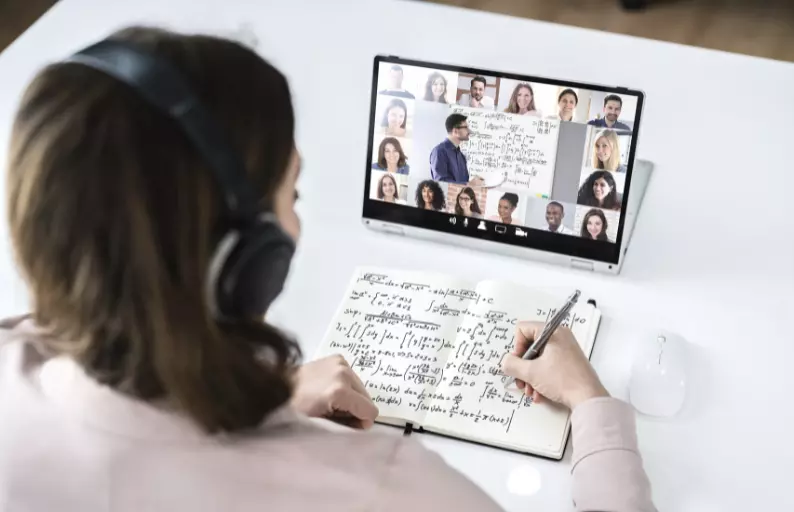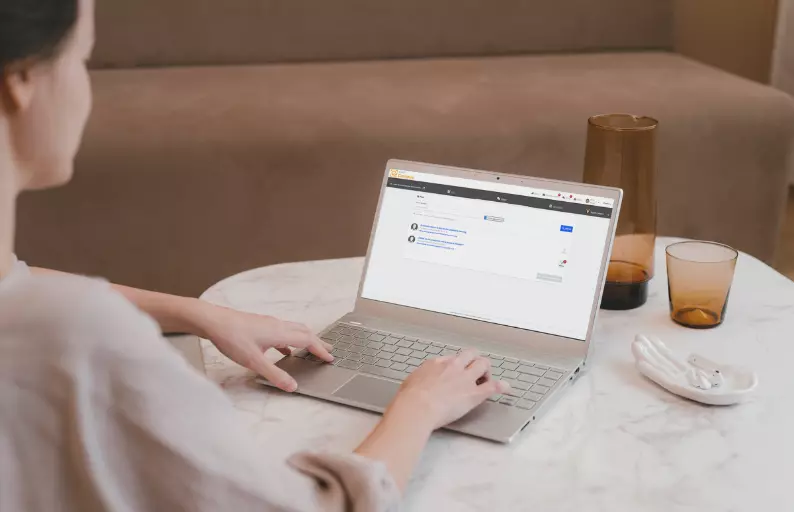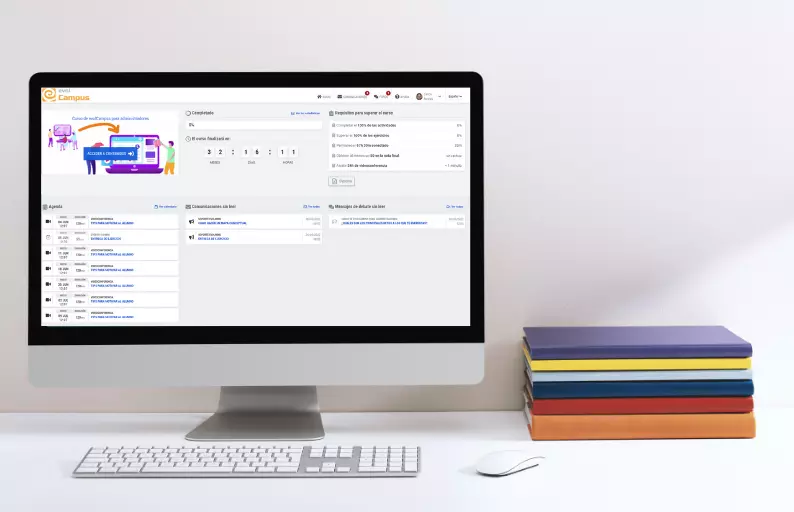Do you truly grasp the benefits of a virtual classroom? Do you know in depth what it offers to the teacher and the student?
In this article, we’ll explain what it is, what it’s for, and delve into its benefits and other details so you can determine if it’s what you need to teach your classes remotely.
Take note!
Characteristics and benefits of a virtual classroom

Differences between the virtual classroom and the traditional classroom
Although the virtual classroom stands out for its capacity for two-way communication, as if it were a traditional educational classroom, virtuality, as we will see below, is what makes the difference.
In contrast to the traditional classroom, the door to the online classroom is always open and presents a completely different dynamic.
Later on, we will discover what a virtual classroom is and we will delve into its characteristics. In particular, to clear up confusion with regard to e-learning platforms.
To cite the basics:
- Classes are taught via a computer (with a good internet connection, of course).
- Trainers must be specialised in e-learning methodology.
- Trainees participate in the training from any destination and in an active way.
What is a virtual classroom?

First of all, it should be clarified that a virtual classroom is the digital environment in which the exchange of knowledge takes place, making real-time learning possible.
In other words, a virtual training classroom is the space, within the elearning platform, where teachers and learners share content in real time, and where queries, doubts and evaluations of the participants are dealt with.
As such, it has no physical or (always) temporal limits. The student can access it whenever he/she wants to take classes, without having to be subject to physical displacement.
In any case, it can be used for distance learning or as a complement to a face-to-face class.
What is a virtual classroom for?
Virtual classrooms are used to develop classes and are one of the main nuclei of training platforms.
As we mentioned a few lines ago, they are a space integrated in a platform. However, in addition to sharing certain tools, which we will see below, they are not the same thing.
Mainly, in the virtual classroom, classes are taught in real time. However, in an e-learning platform, the learner can also receive training asynchronously.
In other words, the learner can find synchronous and asynchronous resources, and administrators and tutors can find materials to create, deliver, manage, evaluate and monitor the training process and the evolution of the course.
Among other things, virtual classrooms are used to foster contact between teacher and learners.
In fact, they are the ideal place to ask questions, propose activities or solve doubts, not only by posing them to the teacher, but also by using other learners’ own questions.
Specifically, global classrooms are one of the ways used to involve students by encouraging interaction, as they are equipped with certain tools that make this possible.
We are referring to chats, forums or videoconferences, which are ideal (or at least should be) for communicating with teachers and students in a direct and easy way.
On the other hand, it also offers tools to create and upload audiovisual class materials, and others to follow the evolution of the learners throughout the course.
In short, with a global classroom you can teach your classes without complications and host a large amount of easily accessible and downloadable content (by subject or module).
Now that you know what a virtual classroom is, read on and get to know its benefits!
Is it compatible with the traditional classroom?
Of course they are. The virtual classroom and the traditional face-to-face classroom are not only compatible, but also mutually reinforcing, multiplying the benefits of each of the models.
Face-to-face training, when supported by the virtual classroom, has extra resources that facilitate the training process. The virtual classroom will become an extension of the material taught in class, as it allows the contents to be adapted to the pace and learning style of each student.
Teachers will be able to include complementary material, revision activities and videos so that students can internalise the knowledge better. In addition, they will be able to maintain more fluid communication with the students. They will not only have contact during the face-to-face class, but they will also have video calls, chat, messaging or forums where they can share impressions and find out how the students experience the training given. The monitoring of students will be strengthened with the virtual classroom, as sometimes, when the student walks out the door, we lose track of them.
The virtual classroom can become a point where the entire course can be centralised, not only for classes in real time, simulating face-to-face training, but also to maintain more fluid communication between the different actors in a training course, thus achieving a higher success rate in the completion rate. Therefore, the virtual classroom and the traditional classroom are 100% compatible and convenient.
Who is a virtual classroom useful for?
As we mentioned before, the virtual classroom will always be beneficial as it prolongs the experience of face-to-face training. It will be useful for training centres, companies or any type of organisation, especially if we look at the following profiles:
- For those who want or need to study at their own pace: either because they like to organise their own way or because work or family commitments do not allow them to do so, the virtual classroom is the ideal tool for them. Students will be able to adapt much better to the classes.
- For those for whom distance is a problem: either because they are in a different location or because they have reduced mobility. The virtual classroom will allow you to follow the classes also in real time without missing anything, with the convenience of connecting from wherever you need to.
- For learners with special needs: the virtual classroom will be a key tool and an inclusive option for learners with disabilities or special needs. They will be able to have subtitles, volume adjustment, visual and other adjustments to follow the training correctly.
- For teachers who want to offer added value: in many occasions time is limited and teachers want to transmit more information so that students are better prepared and satisfied with the course. The virtual classroom will allow you to have direct communication between users to offer extra material or a greater number of sessions that, in person, would be unsustainable.
Who is a virtual classroom useful for?
- Traditional virtual classroom (LMS): the most complete, platforms such as evolCampus from which to teach and manage all the training: from enrolment, content creation, dynamisation and interaction, monitoring, evaluation and analysis of the courses. They are ideal for centralising the entire training process.
- Collaborative virtual classroom: those such as Google Classroom or Microsoft Teams, which are simpler and are reduced to fostering collaboration between students through chats, forums and shared documents. They facilitate teamwork, group discussions and the exchange of ideas.
- Autonomous learning classroom: platforms such as the well-known Coursera or Udemy, where students learn at their own pace with resources that are always available for consultation.
- Live virtual classroom: tools such as Zoom or Google Meet, which in addition to personal or professional use in the business world, are also used to conduct classes in real time, allowing direct interaction between teachers and students. In this model, communication is direct between students and teachers, with live interaction, with the possibility of sharing screens or using digital whiteboards.
- Gamified classroom: these classrooms include game mechanics to make learning more interactive and motivating, such as Kahoot or Classcraft. They promote active learning by using points, achievements, rewards and other competitive elements to make learning more engaging. They are ideal for complex subjects or subjects that require high participation.
- Adaptive classroom: platforms that personalise content according to the progress of the learner, adapting to their needs. This is achieved through artificial intelligence algorithms, enabling tailor-made education.
- Hybrid classroom: combines the best of face-to-face and virtual classes, offering flexibility to students, as in the blended learning model. They have face-to-face and virtual interaction in real time, as well as access to complementary content. A very complete experience for the student, integrating the best of both worlds.
- Inclusive classroom: designed for students with disabilities, with accessible tools such as screen readers or subtitles. It favours the integration of all students, guaranteeing equal access to knowledge.
- Non-formal classroom (training): For continuous professional training, with short, practical courses, such as LinkedIn Learning. Here learners access courses aimed at developing skills specific to their career or interests. They usually cover a wide range of topics with a short, practical approach for short-term application.
- Continuous assessment classroom: these allow for frequent assessments with instant feedback, such as Quizlet. They are useful for identifying areas for improvement in time through automated assessments, interactive quizzes and instant feedback.
Advantage and disadvantage of virtual classroom

Advantages of virtual classroom
Let’s explore the advantages of virtual classrooms for students, teachers, and educational institutions.
Goodbye to geographical barriers
For a start, this tool gives access to a wide range of teachers and educational establishments around the world.
At the same time, it makes it possible for students to share knowledge with other cultures, thus breaking down barriers of communication, location and time.
Saving time and money
Afterward, another of the benefits of virtual classrooms is that it allows you to do more with less. In other words, it saves on material resources such as notebooks, sheets, and prints since the content is already available online.
It also saves time. By allowing connection from anywhere and at any time, it not only reduces costs, but also adds hours to invest in other tasks.
More resources, new possibilities
As you know, we need to provide learners with materials in different formats.
By providing audio and video resources, monotony disappears and learners have the option to access the recordings whenever they want. That’s what e-learning is all about, isn’t it?
Differentiated and flexible learning
Afterwards, it is an ideal solution to facilitate the assimilation of knowledge without becoming demotivating.
In this way, students with greater difficulties gain more confidence and self-confidence, as they can access the material at any time.
At the same time, they can help themselves with complementary documents and count on the support of the tutor or other colleagues in a collaborative way.
Continuous interaction
In the same way, the student can be informed of the timetable of the teacher’s activities for consultations or tutorials, something that favours group cohesion.
Responsibility for learning
Finally, we would like to emphasise that technology, among other things, makes it possible to order documents and make them available.
In other words, students can access them whenever they want.
Therefore, students with organisational problems will find the virtual classroom a new, more flexible way of learning.
Virtual classroom, disadvantages
Beyond understanding the benefits of virtual classrooms, it’s crucial to explore their drawbacks.
Fortunately, these challenges are not insurmountable, as they primarily stem from human factors that can be addressed and resolved.
The role of the teacher
Whether in a global classroom, a virtual campus or a distance learning platform, the role of the online teacher is decisive.
That is to say, the teacher must be qualified and have certain requirements, such as mastery of technologies, the creation of digital materials or be a good counsellor in this environment. To name but a few.
Therefore, if the teacher is not familiar with e-learning training, opting for a remote classroom can be negative.
Technology
At the same time, there is the handicap of technology and poor internet connections.
In this sense, students must have sufficient technological resources to access virtual classes. And, of course, to be able to attend them normally and without the risk of crashes of the educational platform or the Internet.
You already know what a virtual classroom is, the disadvantages it can bring and the advantages it offers for teaching.
Now let’s take a closer look at the tools you should use to meet your training objectives… and those of your students!
Virtual classroom tools

How to make a virtual classroom with substance if we don’t have the necessary tools!
These are the right ones to achieve good results:
- Audiovisual content and materials for the different subjects.
- Calendar of events and activities.
- Internal messaging for asynchronous two-way communication between teachers and students.
- Discussion forums for the implementation of activities.
- Chat for learners to interact with the teacher.
- Various tasks and activities. Both uploads and downloads by the student and the teacher.
- Configurable developmental or self-training tests and exams.
- Certificates or diplomas that students can download.
- Grades of exams, assignments or forums.
- Videoconferencing for work sessions, tutorials or webinars (with the corresponding online whiteboard).
- Student or course progress reports.
Tips on how to create a virtual classroom
First of all, when creating a virtual classroom you have to have the necessary logistics for distance learning.
We are talking about:
- Computer
- Webcam
- Smartphone or tablet
- Headphones with microphone
- Internet connection
Once we have found the basics, we will be able to create the classroom environment.
These recommendations will come in handy!
1. Define very well the topic of your class and the objective you are pursuing with it.
2. Get to know the platform in depth, the possibilities and tools that you and your students will have to use.
3. Equip yourself with sufficient technological resources in case any of the ones you use suddenly fail.
4. Prepare the class in detail in order to get to the point and quickly clarify any doubts arising from the lessons.
5. Put yourself in the learner’s shoes and try simulating the lesson to see what you will find and establish solutions or improvements.
6. Engage learners with ingenuity, using a variety of content and making use of the tools offered by the platform.
7. Control the environment from which you will teach the virtual classroom (lighting, ambient sounds, camera placement).
8. Pay attention to your appearance, posture and voice.
Best platform for online classroom

In reality, there are many global or virtual classroom platforms. Here’s how to create an online classroom
However, in order for a remote class to be delivered with total quality and comfort, it has to integrate a series of qualities, many of which are, of course, related to the platform on which you will carry out the remote class.
evolCampus, for example, offers a virtual classroom designed so that anyone can use it with total agility, no matter how unfamiliar they are with distance learning.
It also offers the synchronous and asynchronous tools required for online classes.
These are:
- Bulletin board from which to send messages and report on activities, communications, exercises...
- Calendar to schedule activities, videoconferences or any other event.
- Discussion forums for group activities
- Internal messaging for the purpose of sharing information, rules or files with students or teachers.
- Chat for teachers and students to interact
- Videoconferencing (Zoom, Microsoft Teams, Google Meet and other relevant providers)
- Certificates and accreditations are customisable and downloadable.
- Monitoring reports on students, teachers, activities...
Thanks to the integration of these resources, the educational activity and the dialogue between teacher and student is excellent.
It also has other useful tools for:
- Upload or create multimedia content and to manage online classes in a fast and automated way.
- Evaluate and follow up the course
It is also a classroom adapted to provide subsidised training to companies, as it strictly complies with the regulations in question.
In short, virtual classrooms are part of the present (even more so in the wake of the pandemic).
Whether you want to offer supplementary classes to a curriculum, a blended programme or fully online training, look for an easy, convenient and effective learning paradigm.
How does the virtual classroom differ from the LMS or elearning platform?
Coming to the end of this post, some of you may now need to clarify the differences between virtual classroom and LMS or elearning platform in order to know what to choose. Both expressions, depending on the context, are used interchangeably, but although they are related to each other, they have different functions within online training.
A virtual classroom is an online teaching and learning space where learners can interact both with the resources and with the teacher and peers. In a virtual classroom, communication and collaboration tools are essential: forums, chats, videoconferences and digital whiteboards facilitate constant interaction. The main objective of the virtual classroom is to offer an active and participative learning experience, where students not only consume information, but can also share ideas, resolve doubts and collaborate with each other in real time. In addition, it usually allows the integration of multimedia resources (videos, podcasts, interactive readings), which favours dynamic and flexible learning.
On the other hand, an LMS platform or elearning platform concentrates everything on the same platform, being oriented towards the delivery and management of the entire training process. It allows to organise, distribute and track the progress of courses and learners. LMS platforms can include everything necessary or only certain interactive functionalities, as they are more focused on the structure of the course: enrolment management, distribution of materials, administration of assessments and tracking of student performance. Interaction in some of these is more limited, generally focused on the submission of assignments and exams.
In short, the main difference lies in the approach. While the virtual classroom focuses on providing an interactive, flexible and collaborative environment for active learning, the LMS aims at efficient course management, managing resources, assessments and tracking student performance. Both are complementary, but play different roles within the online education ecosystem. The best? A platform to centralise the whole process, simplifying the work of tutors, teachers and administrators.
